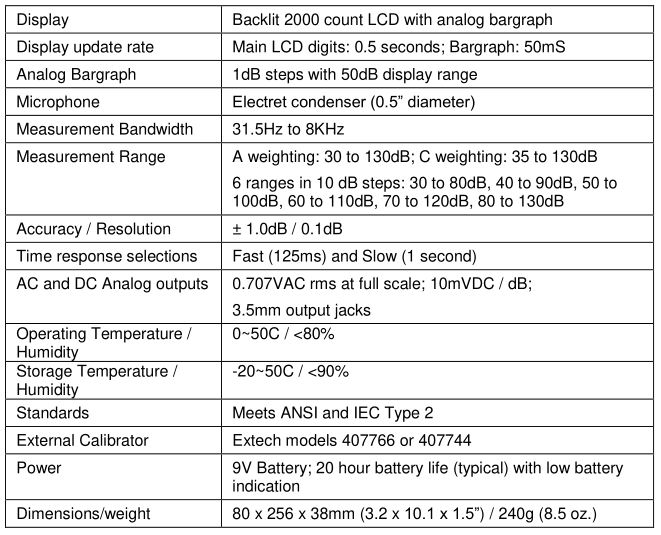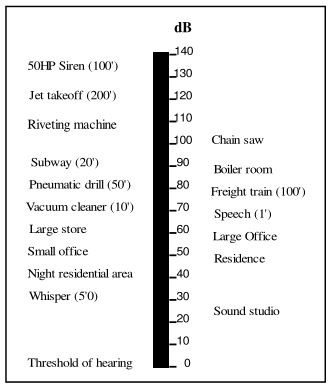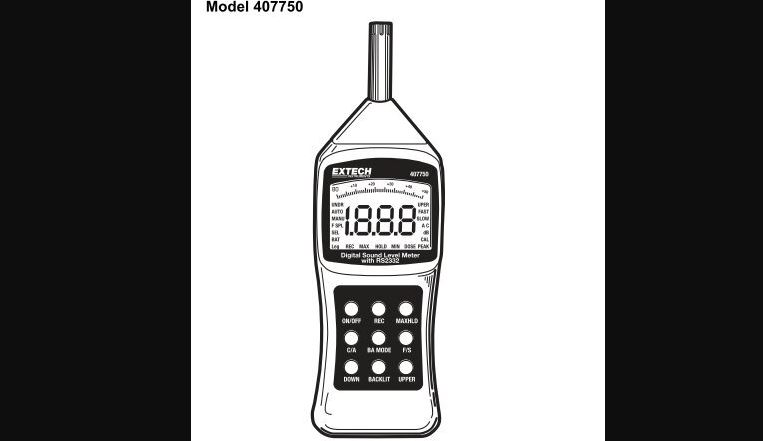EXTECH Digital Sound Level Meter User Manual

Additional User Manual Translations available at www.extech.com
Introduction
Congratulations on your purchase of the Extech 407750. This device measures sound level in dB and the measurement range can be set automatically or manually. The 407750 offers selectable frequency weighting (`A’ and `C’) and Time Response (Fast and Slow). The built-in RS-232 PC interface allows the user to record readings onto a PC in real-time. Careful use of this meter will provide years of reliable service.
Meter Description
 1. LCD Display2. Microphone3. ON/OFF key4. REC (Record) key5. MAXHLD (Max Hold) key6. C/A Weighting Select key7. BA (Background Absorber) key8. F/S Fast / Slow Response select key9. DOWN10. Backlit (LCD backlighting) key11. UPPER12. AC adaptor jack13. Calibration screw adjust14. AC analog output jack15. DC analog output jack16. RS-232 output jack
1. LCD Display2. Microphone3. ON/OFF key4. REC (Record) key5. MAXHLD (Max Hold) key6. C/A Weighting Select key7. BA (Background Absorber) key8. F/S Fast / Slow Response select key9. DOWN10. Backlit (LCD backlighting) key11. UPPER12. AC adaptor jack13. Calibration screw adjust14. AC analog output jack15. DC analog output jack16. RS-232 output jack
Note: The Battery Compartment and the Threaded Tripod mount access are located on the back of the instrument (not pictured)
Operation
Quick Start
- Power the meter by pressing the ON/OFF key.
- The meter’s LCD will count down to zero (99.9, 88.8, 77.7, etc.) and then begin measuring sound levels. If the LCD does not switch on after pressing the ON/KEY check the 9V battery.
- Point the microphone toward the source of the sound level to be measured and view the reading on the meter’s LCD.
`A’ and `C’ Frequency WeightingSelect `A’ or `C’ weighting via the C/A key. The LCD will reflect the currently selected frequency weighting. Use `A’ weighting to have the meter respond as the human ear would with regard to frequency response (the human ear boosts and cuts amplitude over the frequency spectrum). `A’ weighting is used for environmental measurements, OSHA regulatory testing, law enforcement, and workplace design. Select `C’ weighting for flat responding measurements (less amplitude boost or cut across the frequency spectrum). `C’ weighting is used in applications where hearing conservation is not an issue; for example, in the diagnosis of malfunctions in electrical, electronic and mechanical devices.
FAST/SLOW Response TimeSelect either FAST (125ms response) or SLOW (1 second response) measurements by pressing the F/S key. The LCD will reflect the currently selected mode. Selection of `Fast’ or `Slow’ is determined by the application and any directives or standards related to that application. For example, most hearing conservation or OSHA related testing is done using SLOW and A weighting.
MAX HOLDThe meter is capable of taking continuous measurements and only updating the LCD when a higher reading (than the one presently on the display) is detected. The bargraph display continues to change while the main LCD waits for a higher reading. Press the MAXHLD key to activate the MAX HOLD mode. The LCD will reflect the MAX HOLD function. Press the MAXHLD key again to return to normal operation.
Record (REC) FunctionTo Record the Maximum and Minimum sound level measurements over a programmable period of time, press the REC key. The REC indicator will appear on the LCD. Once the REC key is pressed, the meter begins tracking the highest (MAX) and lowest (MIN) readings. Press the REC again and the MIN indicator will appear on the LCD along with the lowest sound level reading since the REC key was pressed. Press the REC again and the MAX indicator will appear along with the highest reading the meter has encountered since the REC key was first pressed. Press and hold the REC until the REC indicator extinguishes to exit the RECORD mode.
BA (Background Noise Absorber) ModeThe Background Noise Absorber allows the user to accurately measure equipment noise by “eliminating” background noise. The Sound Level Meter first stores the background noise as a reference level. From there, when a sound is measured, the display will show the sound level measurement minus the background noise. To operate the meter in BA mode, follow these steps:
- Power the meter.
- Press the MAXHLD key (the MAX HOLD icon will appear on the LCD).
- Press the BA key (`F” will appear to the left of the SPL display icon).
- Press the MAX HOLD key again (the MAX HOLD icon will reappear on the LCD).
- The meter is now displaying the background, reference noise.
- Power the device under test and note the new sound level meter reading.
- If the reading changes, the new reading is the sound level of the device. If the reading does not change, the noise produced from the device is either equal to or less than the background noise.
- Press the BA key again to return to the normal mode of operation.
Auto and Manual RangingThe meter powers up in the Automatic Range mode. In automatic mode the meter automatically finds the correct range in order to produce the best accuracy. However, if it is desired to set the range manually, follow these steps:
- Power the meter
- Notice the two (2) digit number to the immediate left of the analog bargraph. This number is the low end of the presently selected range (see the specifications for the ranges).
- To change the range, press the UP key to raise the range or press the DOWN key to lower the range. The two digit number on the left of the bargraph will change with each key-press.
- An advantage of Manual mode is that it takes less time for the meter to take a reading. In Auto Range mode the meter must first locate the correct range before displaying a measurement.
LCD BacklightingPress the BACKLIT key to illuminate the LCD. The backlight will remain on for 5 seconds and then automatically switch off to preserve battery life.
Auto Power OffTo preserve battery life, this meter has an automatic power off feature. If the unit is not used for approximately 20 minutes, the meter shuts off. To override this function, follow these steps:
- From a power OFF condition, press and hold the ON/OFF and MAX HOLD keys simultaneously.
- When `n’ appears on the display, release the MAX HOLD and then the ON/OFF key.
- The Auto Power Off feature is now disabled. Note that the Auto Power Off feature is re-activated the next time the meter is powered down.
RS-232 OutputThe meter includes an RS-232 PC interface jack. This PC interface allows the meter to store and display readings on a PC as they are recorded. The interface cable and 407752 software for data acquisition are sold separately. Detailed instructions are provided with the software.
Analog OutputsThe meter includes an AC and a DC analog output. These outputs are proportional to the displayed sound level and are ideal for use with chart recorders and dataloggers. The labeled 3.5mm output mini-plugs are located on the bottom of the instrument.
The DC output is 10mV per dB.The AC output is 0.707V rms full scale.
Calculate the AC value per dB in the range 0.707*10(dB – max dB of range)/20
Example: 30-80dB range80dB = 0.707Vrms70dB = 0.707 * 10(70-80)/20 = 0.707 * 10(-.5) = 0.223Vrms50dB = 0.707 * 10(50-80)/20 = 0.707 * 10(-1.5) = 0.022Vrms
Calibration
To calibrate the meter, an external calibrator such as the Extech Instruments 407744 or 407766 is required in addition to a small screwdriver.
Turn the meter on and set the parameters of the 407750 to the following before proceeding:
Response: FastFunction: A weightingRange: 50 to +100 dB
Place the calibrator gently over the microphone of the meter. Set the calibrator to output 1kHz sine wave at 94.0dB. Adjust the calibration potentiometer, located at the bottom of the meter, until the display shows a reading of 94.0 dB.
Battery Replacement
When the low battery message appears on the LCD, the 9V battery has fallen to a critically low voltage level and should be replaced as soon as possible. The battery compartment cover resides at the rear of the meter. Remove the rear battery compartment screw and remove the battery compartment cover, change the battery, and replace the compartment cover.
![]() Never dispose of used batteries or rechargeable batteries in household waste. As consumers, users are legally required to take used batteries to appropriate collection sites, the retail store where the batteries were purchased, or wherever batteries are sold.
Never dispose of used batteries or rechargeable batteries in household waste. As consumers, users are legally required to take used batteries to appropriate collection sites, the retail store where the batteries were purchased, or wherever batteries are sold.
Disposal: Do not dispose of this instrument in household waste. The user is obligated to take end-of-life devices to a designated collection point for the disposal of electrical and electronic equipment.
Specifications

Reference Information
Frequency Weighting Characteristics

Typical A-Weighted Sound Levels

Copyright © 2013-2019 FLIR Systems, Inc.All rights reserved including the right of reproduction in whole or in part in any formISO-9001 Certifiedwww.extech.com
References
[xyz-ips snippet=”download-snippet”]

